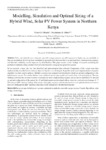Modelling Simulation and Optimal Sizing of a Hybrid Wind, Solar PV Power System in Northern Kenya
Abstract
Solar and wind, the most abundant renewable energy resources are still expensive to deploy and are unreliable as they are intermittent. It has long been postulated in open published literature that solar and wind have complementary regimes, and that their reliability can be improved by hybridization. This paper reports on the findings of research examining the problem of optimally sizing a hybrid wind and solar renewable energy power generation system.
In the research, a target site was first identified and meteorological data collected. Components of the system were then mathematically modelled from which an objective function was developed. A parallel multi-deme implementation of genetic algorithm was then used to optimize. Multiple scenarios were prepared and simulated to obtain an optimal configuration of the hybrid power system. The results obtained were validated against openly published results from real word projects. The key findings confirmed that on some locations wind and solar have complementary regimes and can thus be hybridized. To this end an optimal configuration of the system for off-grid deployment was developed with an attractive levelized cost of energy of 17 US cents per kWh. Another finding of the research decoupled resource optimal solutions from cost optimal solutions in that the least cost configuration didn’t necessary maximize on the utilization of the abundant resource.

